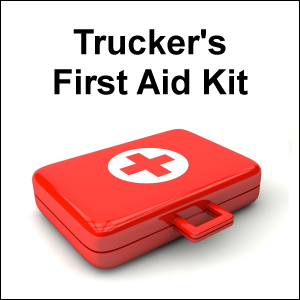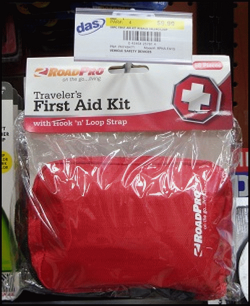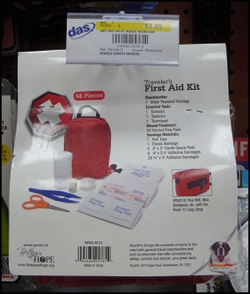Sure, you can buy a commercial first aid kit — and get what the manufacturer wants you to have at the price they want you to pay.

For instance, take a look at the kit (shown below) which we found for sale at a truck stop.
 The first thing we noticed is the brand name.
The first thing we noticed is the brand name.
Does this “manufacturer” specialize in medical supplies, health and wellness items or first aid?
No.
 The second thing we noticed was the size.
The second thing we noticed was the size.
It’s small.
Now this may be all that you need.
The compact size may be just right in your truck.
The third thing we noticed was the price: $9.99.
When you truly have an emergency, you may wish that you had spent this amount to get the materials you need.
Because the photo of this “Traveler’s First Aid Kit” is pretty small, you may not be able to read the contents.
So we’ll list the 58 pieces it contains:
- Contents:
- 1 Water Resistant Package
- Essential Tools:
- 1 Scissors
- 1 Tweezers
- 1 Tourniquet
- Wound Treatment:
- 20 Alcohol Prep Pads
- Bandage Materials:
- 1 Roll Tape
- 1 Elastic Bandage
- 4 2″ x 2″ Sterile Gauze Pads
- 8 4″ x 2-1/2″ Adhesive Bandages
- 20 3/4″ x 3″ Adhesive Bandages
But what if you could assemble your own first aid kit for less?
After all, can’t you just take this list (or another) of the contents and go shopping?
Sure you can!
Most any department store with a health and beauty aids section or a pharmacy will have what you need.
Custom First Aid Kit
When you are custom tailoring your first aid kit with the contents you want, there are a few things to bear in mind.
1. You will have to determine if name brand products are worth the extra cost over generic.
For example, do you really have to have Band-Aid® bandages or will another less expensive brand (or even a store brand or generic if it is available) work just as well?
Compare these products from Amazon.com, with which we have an affiliate relationship:
- Band-Aid Brand Adhesive Bandages Sheer, All One Size, 100 Count (Band-Aid Johnson & Johnson Band-Aid, Sheer, Comfort-Flex, 3/4 in. x 3 in., 100-Count Boxes (Pack of 4))
- First Aid Only 3/4″ X 3″ Fabric Bandages, 100-Count Boxes (Pack of 3) (First Aid Only 3/4 in. fabric 100-count boxes (pack of 3)
- Plastic Adhesive Bandages Strips 1″ X 3″ 100/box (PLASTIC ADHESIVE BANDAGES STRIPS 1 in. x 3 in. 100/box)
2. Certain parts of a first aid kit may be sensitive to temperature or humidity.
Furthermore, some items may have a limited lifespan.
- For example, if you store latex gloves in your kit, they may become hard and brittle over time, rendering them completely useless.
- Individually wrapped alcohol pads or hand cleaning wipes can dry out. (Watch out for punctures in the packaging.)
- Any kind of medication such as a fever reducer or antibiotic cream can expire.
We once had a commercially prepared first aid kit tucked away in the truck of our car; over time, one of the medicine pouches burst and the entire contents became exposed to the resulting white powder.
Vicki got a rude little surprise when she opened the box later.
So, you will want to schedule periodic inspections of your kit to make sure that it is up-to-date.
(One way to remember this is to do it twice a year in six month intervals, such as the dates when the spring and autumn seasons begin.)
3. What will you store your first aid kit in?
Most commercially-prepared kits come in a plastic box not unlike a lunch box with a handle, which can repel water (if not be completely waterproof).
Most lunch boxes are “cute” (because they’re for kids), so you may prefer just a plastic shoe box or other type of box.
You can usually find these at a dollar store.
However, you will want to bear in mind the size (to make sure it can hold everything you want to store in it) and what type of lid it has (separate or hinged).
Shown here are boxes from Amazon.com, with whom we have an affiliate relationship.
We have found that a hinged lid works well for us because it can’t get lost.
4. Even though we encourage you to think ahead on these matters, too, don’t confuse a first aid kit with
- either a bug out bag (aka “emergency preparedness kit“);
- or “disaster survival kit” (that contains other emergency items);
- or a medicine chest (that contains medicines for all sorts of ailments).
5. For your first aid kit, you will want to concentrate only on items to be used for minor injuries.
Also, you don’t have to go overboard and buy a bunch of medical supplies you’ll likely never use.
Wikipedia has a long list of things that you can put in a first aid kit, much of which many truck drivers may never need or use.
Of course, what you put in your kit is up to you.
6. Other items that you may not necessarily consider part of a first aid kit may be entirely appropriate.
For example, we read years ago that in the event of an accident in which a part of the body bleeds profusely, it would be a good idea to have in our kit something to absorb blood.
(Guys don’t usually consider this, but products already exist to do this.)
So, we have in our first aid kit a bunch of individually wrapped feminine napkins or pads.
If you’re too embarrassed to buy these, we understand.
Perhaps your home support team member can buy them for you.
7. Recommendations on what to put in a do-it-yourself first aid kit vary widely.
What one person or organization lists may not match anyone else’s list.
And obviously, since there is a wide variety of commercially prepared kits for sale, there are varying lists of components.
8. The most basic kit, in our opinion, ought to be a box of adhesive bandages (in various sizes) and a tube of antibiotic ointment.
Hopefully, these items will be all you need to handle your everyday injuries like paper cuts and skinned knuckles.
However, we also have list of items you may consider assembling for your own kit, available through our free downloads page.
You may also wish to consider have some natural items (travel emergency and remedies) in your kit.
9. Be aware that where you store your first aid kit in your truck may be important.
- If you put it on the floor, is it likely to get stepped on, kicked or dirty?
- If you put it under your bunk, will you be able to access it in a hurry (especially if you’re injured and can’t raise the bunk with both arms/hands)?
- If you put it in a “warm” spot, are the contents likely to go bad faster?
10. Note: since 2012, we have personally used 100% pure, therapeutic grade essential oils for many health needs.
There is a group of 10 “everyday” essential oils that we recommend.
A few of them are our favorites.
![]() Money saving tip: Some items may be available for less at dollar stores.
Money saving tip: Some items may be available for less at dollar stores.
However, some generic (non-name brand) items may not have the quality you want or need.
If you need a commercially prepared first aid kit, compare contents and costs.
Remember that although some kits may have a greater number of components, not all of those components may be needed as often (or at all).
Evaluate your “need” to buy a kit (or components) at a truck stop.
Some items available for sale there are unusually at a much higher price than you can buy them at a regular retail store.
Remember that items sold at truck stops are geared for convenience but not cost savings.
If you have a home support team, encourage your team member(s) to shop around for you.
The reason for having this kind of kit is in the event that you, someone with you or someone whom you will encounter needs first aid.
You may never be able to predict the type of injury or accident you may encounter — or the exact first aid items you will need during such an encounter — but you want to be as prepared as possible.
The alternative to not being prepared with basic medical supplies is not a pleasant one: you will have to improvise, which may not be in your best interests.
So, for your own well being, set a goal to obtain, make or inspect your in-truck first aid kit now.
Return from In-Truck First Aid Kit: Do-It-Yourself Versus Store-Bought Kits to our Health and Wellness page or our Truck Drivers Money Saving Tips home page.









